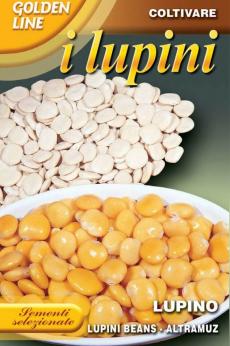
Bean, Lupini Beans - Edible Lupino More coming in February :)
LUPINI BEANS Lupini. A mid-early dwarf plant about 18" high. Plant 3/4" deep every 2", rows 18" apart, after last frost. Thin to 1' between plants. Plants require a steady supply of water. Produces numerous pods which mature in stages from the bottom branches up. Havest as the flowers die. The beans are versatile in the kitchen and are excellent in stews and soups. Often sold in brine jars, and eaten like edamame. Plant lupini in a section of your garden that is in shade for part of the day, which will help keep it cool when the temperatures are hot. Break up the ground with a tiller so that it is loose. Lupini beans prefer a soil pH level between 4.5 and 7.5. Plant one lupini bean seed every two inches in a row, so that each seed is approximately three-fourths of an inch deep. Cover the seeds with soil. If you're planting more than one row of lupini beans, space the rows a minimum of 18 inches apart.
Thin the seedlings when they are approximately 1 inch tall, removing each seedling that appears thin or weak. You should leave two to three plants per 12 inches of land for optimal bean yield. Water the plants every few days, simply moistening the soil's surface, adjusting as necessary based on the weather; water more often in hot water, and less when it rains. Lupini beans do not like a lot of water, and it is better to slightly underwater than to over-water. Lupini beans should be fertilized with soybean fertilizer, or with fish emulsion if you want to grow the beans organically. 100 gram (3.5 oz.) box. approximately 2-10 seeds per gram.
Processing Lupini beans (this is for Lupinus Albus!) Or other sweet Lupines.
Cover the lupini beans with 6 cups of water and let them soak overnight. Drain in a colander and rinse the beans with fresh water. Place the lupini beans in a large pan, cover them with several inches of water and let them simmer, with the lid on the pan, for 60 minutes. Drain in a colander and rinse the beans again.
Cover the beans with lightly salted water and refrigerate for 24 hours; then drain, rinse, cover again with lightly salted water and refrigerate for another 24 hours. Repeat this process for five days,Or until the discard water no longer tastes bitter. With some sweet Lupini, this may take only 2 changes of water. Keep the beans refrigerated and covered in lightly salted water in a sealed container for weeks.
Serve the lupini beans by draining them and tossing them with olive oil and black pepper. They are also good with a squirt of fresh lemon juice or in a green salad.
** Italy's University of Milan reported in the journal "Molecular Nutrition & Food Research" that neither cooking nor soaking is required for sweet lupini beans. In their 2008 study of a variety of beans and foods made with lupini, the researchers determined that commercially available, sweet lupini beans are safe to eat without any debittering due to their low alkaloid content.
But you cannot eat the lupine's legume raw; it is overpoweringly bitter, even acrid, and toxic as such. Dried lupini must be soaked for two days, cooked for (at least) two hours and soaked in a refrigerated, light brine for upwards of two weeks — all in order to leach out that bitterness and danger. See our instruction sheet included with your order.
